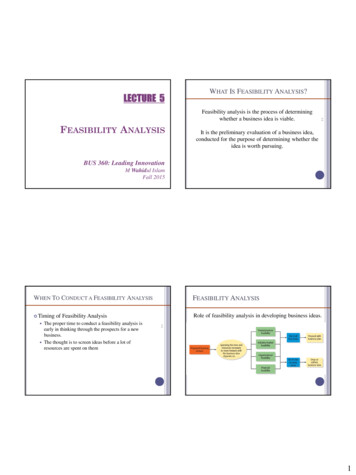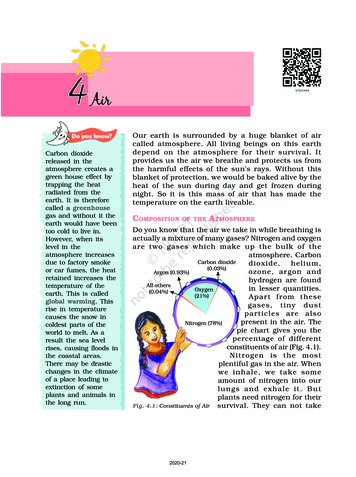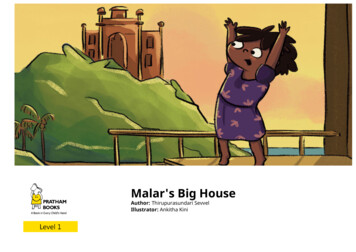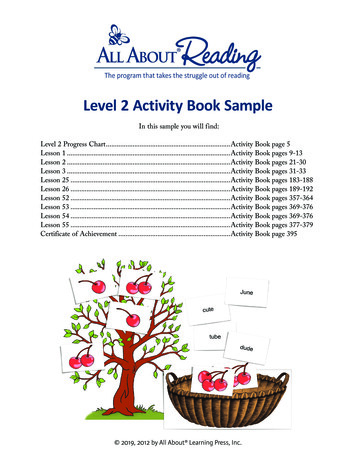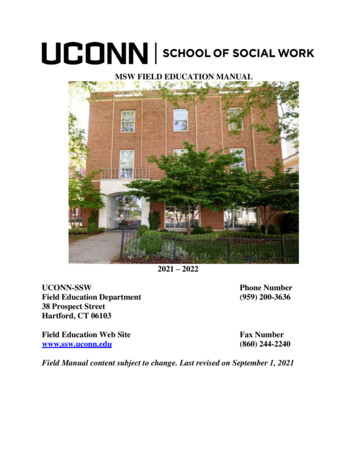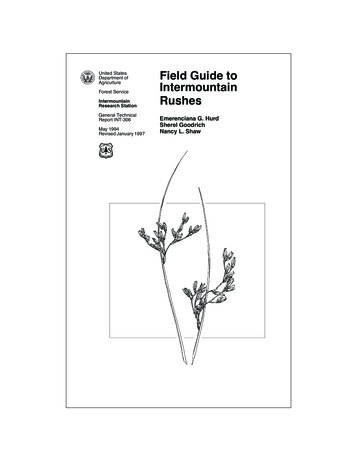
Transcription
United StatesDepartment ofAgricultureForest ServiceIntermountainResearch StationGeneral TechnicalReport INT-306May 1994Revised January 1997Field Guide toIntermountainRushesEmerenciana G. HurdSherel GoodrichNancy L. Shaw
THE AUTHORSEMERENCIANA G. HURD is botanist with the Intermountain Research Station at the Forestry Sciences Laboratory in Boise, ID.Originally from the Phillipines, sheholds a B.S. degree in biology fromWhitman College, Walla Walla, WA,and M.S. and Ph.D. degrees inbotany from Northern ArizonaUniversity.SHEREL GOODRICH is range conservationist for the Ashley NationalForest, Vernal, UT. He received aB.S. degree in range managementfrom Utah State University in 1971and an M.S. degree in botany fromBrigham Young University in 1981.He worked extensively in Utah andcentral Nevada when he was withthe Intermountain Research Station, Provo, UT.NANCY L. SHAW is botanist withthe Intermountain Research Stationat the Forestry Sciences Laboratoryin Boise, ID. She completed a B.S.degree in zoology at the College ofIdaho, an M.S. degree in botany atIdaho State University, and a Ph.D.degree in crop science at OregonState University.ACKNOWLEDGMENTSWarren Clary, Project Leader ofthe Intermountain ResearchStation’s Riparian/Stream Ecologyand Management Research WorkUnit, suggested the idea of developing field guides for grasslike species of Intermountain riparian areas.We appreciate his helpful adviseand leadership in the accomplishment of this work. We offer specialthanks to Joy Mastrogiuseppe, curator of the Marion Ownbey Herbarium, Washington State University, for her taxonomic assistance;Lynda Smithman, IntermountainResearch Station, for her helpfulsuggestions and encouragement;Joe Duft for his assistance withphotography; and Gary Hurd for hiswillingness to drive long distancesin search of uncommon species.Front cover art: Juncus balticus, drawn by Lenora Oosterhuis,an emigrant from Holland, a forest ecologist, and a freelancebiological artist living in Boise, ID.Intermountain Research Station324 25th StreetOgden, UT 84401
CONTENTSPageIntroduction . 1References . 1Morphology . 2Descriptions . 2General Description:Juncus L. . 2Species Descriptions . 7Juncus alpinus . 9J. articulatus . 11J. balticus . 13J. bufonius . 15J. confusus . 17J. covillei . 19J. drummondii . 21J. effusus . 23J. ensifolius . 25PageJ. filiformis . 27J. hallii . 29J. howellii . 31J. longistylis . 33J. mertensianus . 35J. nevadensis . 37J. nodosus . 39J. orthophyllus . 41J. parryi . 43J. regelii . 45J. tenuis . 47J. torreyi . 49J. triglumis . 51J. tweedyi . 53Glossary . 54Index of Common Names . 56
INTRODUCTIONinflorescences, flowers, capsules,seeds, distribution and habitat,and similar species. Line drawings and black and white or colorphotographs illustrate the species’growth habit, inflorescences, fruits,and seeds. After the descriptionsis a glossary of terms used in thisguide. The concluding section isan index of common names.Line drawings in this publication were reproduced fromHitchcock and others (1969), withpermission from the University ofWashington Press. Photographswere made by the senior author.Species descriptions were developed from Davis (1952), Cronquistand others (1977), Goodrich andNeese (1986), Hermann (1975),Hitchcock and Cronquist (1973),Hitchcock and others (1969),Welsh and others (1987), andexamination of specimens in theIntermountain Research StationHerbarium (BOIS), Boise, ID;the Marion Ownbey Herbarium,Washington State University(WS), Pullman, WA; and theHarold M. Tucker Herbarium(CIC), Albertson College,Caldwell, ID.Application of new informationfrom the rapidly evolving fieldsof riparian ecology, classification,management, and restoration requires accurate identification ofthe biological components of theserich and varied ecosystems. In riparian areas, vegetation characteristically includes several taxonomically difficult groups, amongthem the sedges, rushes, willows,and grasses. This guide providesindividuals working in Intermountain riparian areas with atool to aid in identifying membersof one of these groups, the rushes(Juncus spp.).The geographic area consideredin preparing this guide includessoutheastern Oregon, Nevada,Utah, western Wyoming, andIdaho south of the Salmon River.The 23 rushes described includethe common and several lessabundant species. The guide isnot inclusive; readers are advisedto consult comprehensive local floras to verify identifications.This guide begins with morphological illustrations. Then, aftera general description of the genus,species are presented alphabetically by scientific name. Theirtechnical descriptions includecharacteristics of the growthhabit, leaves, involucral bracts,REFERENCESDavis, Ray J. 1952. Flora of Idaho.Provo, UT: Brigham Young University. 836 p.1IntroductionEmerenciana G. HurdSherel GoodrichNancy L. ShawReferencesField Guide toIntermountain Rushes
MORPHOLOGYCronquist, Arthur; Holmgren,Arthur H.; Holmgren, Noel H.;Reveal, James L.; Holmgren,Patricia K. 1977. Intermountainflora: vascular plants of the Intermountain West, USA. Vol. 6.New York: Columbia Press.584 p.Goodrich, Sherel; Neese,Elizabeth. 1986. Uinta Basinflora. Ogden, UT: U.S. Department of Agriculture, Forest Service, Intermountain Region.320 p.Hermann, Frederick J. 1975.Manual of the rushes (Juncusspp.) of the Rocky Mountainsand Colorado Basin. Gen. Tech.Rep. RM-18. Fort Collins, CO:U.S. Department of Agriculture,Forest Service, Rocky MountainForest and Range ExperimentStation. 107 p.Hitchcock, Leo C.; Cronquist,Arthur. 1973. Flora of the Pacific Northwest. Seattle: University of Washington Press. 730 p.Hitchcock, Leo C.; Cronquist,Arthur; Ownbey, Marion;Thompson, J. W. 1969. Vascularplants of the Pacific Northwest.Part 1. Vascular cryptogams,gymnosperms, and monocotyledons. Seattle: University ofWashington Press. 914 p.Padgett, Wayne G.; Youngblood,Andrew P.; Winward, Alma H.1989. Riparian community typeclassification of Utah and southeastern Idaho. R4-Ecol-89-01.Ogden, UT: U.S. Department ofAgriculture, Forest Service, Intermountain Region. 191 p.Welsh, Stanley L.; Atwood, D. N.;Goodrich, Sherel; Higgins, Larry.1987. A Utah flora. Great BasinNaturalist Memoir 9. 894 p.Descriptions in this guide mayperhaps be more easily understood if the reader refers to figures 1 through 3—illustrationsof morphological characteristics.A glossary at the end of thepublication contains further definitions of these characteristicsand of other terms used in thedescriptions.DESCRIPTIONSGeneral Description:Juncus L.Plants perennial, or infrequently annual, glabrous, grasslike; stems caespitose or arisingfew together from rhizomes, tereteto flattened, not jointed, leaflessto leafy; leaves basal or alternate,sometimes 2-ranked; leaf sheathsopen at the base, commonly withhyaline or scarious margins, theseoften prolonged upward on thesides at the juncture with theblade to form rounded to acuminate auricles; auricles rarely extending outward like those ofgrass leaves, but sometimesconfluent, forming a ligule; leafblades lacking or reduced to abristle or well developed and linear, flat, equitant, or terete andoften hollow or filled with pithand septate-nodulose; inflorescence terminal, essentially cymose, from diffuse and paniclelikeor corymblike to greatly congested,sometimes of 1 to many cymoseheads or clusters; the involucralbract reduced to greatly elongateand flat to terete (when terete theinflorescence may appear lateralon the stem); branches, heads,2
General Descriptionstriquetrous capsule, unilocularwith 3 parietal placentae or trilocular from the intrusion of theplacentae; seeds numerous,minute, commonly ellipsoid tofusiform and apiculate, faintly reticulate or areolate, sometimeswith one or both ends prolongedinto a slender tail that may belonger than the body and of softertexture; n 3-36. A genus of morethan 200 species, widely distributed, best developed in moist towet places of temperate and boreal regions.The above description was derived from Cronquist and others(1977), Hitchcock and Cronquist(1973), Hitchcock and others (1969),Goodrich and Neese (1986),Hermann (1975), Welsh andothers (1987).Morphologyand pedicels often subtended bybractlets; flowers few (rarely 1) tomany, small, perfect, greenish topurplish-brown or black, sessile orpedicellate, sometimes subtendedby 2 entire hyaline-scariousprophylls borne at the pedicelapex and directly beneath theperianth; perianth regular, moreor less scarious, chartaceous, orpartly herbaceous or hyaline, often persistent during fruiting; perianth segments 6 in 2 series of 3,equal or the inner series often theshorter; stamens (1, 2) 3 or 6, when3 mostly opposite the outer perianth series; filaments from shorterto much longer than the anthers;ovary superior; style 1, short andinconspicuous to evident; stigmabranches 3, more or less elongate;fruit a small, loculicidal, often3
StigmaInvolucral mentProphyllslackingOuter segmentPerianthInner segmentProphyllsLeaf bladeStemLeaf sheathSeedCapsuleCapsule(valve)Leaf bladeRhizomeAuricleRootsLeaf sheathFigure 1—Rush morphology.4
A. Capsule oblong-ovoid, apexblunt, slightly triquetrous. Perianthsegments broadly lanceolate,margins membranous, apicessubulate. Prophylls present.D. Capsule trigonous-cylindric,apex obtuse mucronate. Perianthsegments oblong-lanceolate,apices acute.B. Capsule cylindric-ellipsoid, apexobtuse (rounded). Perianthsegments: inner-shorter, obtuse;outer-longer, acute.E. Capsule oblong-ovoid, apexobtuse-retuse. Perianthsegments broadly lanceolate,apices obtuse to acute.C. Capsule cylindric-triquetrous, apexacute. Perianth segments narrowlylanceolate, apices acuminate.F. Capsule prismatic-conic, apextapered. Perianth segments narrowlylanceolate, apices acuminate.G. Broadly oblong, H. Narrowly oblong,apex obtuse.apex truncate.I. Narrowly ovoid,apex acute.Figure 2—Morphological characteristics of rush capsules andperianths (A-F) and rush capsules (G-J).5J. Obovoid, apexrounded-retuse.
A.B.apiculate endsBroadly oblong,minutely idged, reticulateDorsiventrally flattenedareoleseptaCylindric-ellipsoid,uniformly apiculate,striateTereteEllipsoid-ovoid,unevenly apiculate,prominently reticulatemidribLanceolate-ovoid,sharply apiculate,finely reticulateEquitantcaudate endsInvoluteChanneledFigure 3—Morphological characteristics of rush leafblades (A) and seeds (B).6Oblong-linear,long-caudate (tailed),finely striate
Species DescriptionsSpecies Descriptions7
01 cm01 mmBCA0Juncus alpinus. (A) Inflorescence, (B) capsule and perianth, (C) seeds.81 mm
Juncus alpinus Vill.Northern rushHABIT: Loosely tufted perennial developing from creeping rhizomes,sometimes rooting at the nodes; stems 4-50 cm tall, surpassing theleaves.LEAVES: 1-3, mostly borne on the lower half of the stem; sheathmargins scarious and prolonged into auricles; blades terete, completelyseptate.INVOLUCRAL BRACT: Usually shorter than the inflorescence,1-7 (10) cm long, sometimes leaflike.INFLORESCENCE: Open, 2-15 cm long; branches ascending to erect;heads 5-30, each 3-6 (10) flowered.FLOWERS: Sessile or equally short pedicelled, prophylls lacking.Perianth segments: Light to deep purplish-brown, 2-2.5 mm long;the inner segments shorter and rounded; the outer oblong, acute ormucronate. Stamens: 6; one-half to two-thirds as long as the perianth;anthers shorter than the filaments.CAPSULES: Ovoid-oblong, distinctly rounded at the tip, incompletelytrilocular, pale to deep brown, 2.5-3 mm long, equaling or surpassingthe perianth.SEEDS: Cylindric- to ovoid-ellipsoid, minutely apiculate at both ends,lightly striate longitudinally, medium brown to dark brown with asheen, 0.5 mm long.HABITAT AND DISTRIBUTION: Seeps, bogs, margins of ponds,lakes, and streams; often on limestone or other basic substrates.Circumboreal, south in North America from Washington to Pennsylvania.Occasional across montane parts of the Intermountain region, mostlywithin the aspen and coniferous forest zones. July-August.SIMILAR SPECIES: Inflorescence branches of J. articulatus aredivergent and its capsules acute. It is generally found at elevationslower than J. alpinus.9
01 cm01 mmBCA0Juncus articulatus. (A) Inflorescence, (B) capsule and perianth, (C) seeds.101 mm
Juncus articulatus L.Jointed rushHABIT: Loosely or densely tufted perennial, 15-50 cm tall, arising fromstout rhizomes and often rooting from the lower nodes.LEAVES: 1-3 per stem, basal leaves much reduced; sheath marginsscarious, prolonged into rounded auricles; blades terete with completesepta.INVOLUCRAL BRACT: Much shorter than the inflorescence, 1-3.7 cmlong.INFLORESCENCE: Open; branches divaricate; heads 4-35, small,2-10 flowered.FLOWERS: Sessile, prophylls lacking. Perianth segments: Deep(pale) brown or greenish with scarious margins, lanceolate, slightlyacuminate, 2.5-3 mm long, about equal or the inner segments slightlylonger with wider hyaline margins. Stamens: 6; anthers shorter thanthe filaments.CAPSULES: Conic-ovoid, somewhat triquetrous, gradually taperingto a stylar beak, unilocular, brown, 2.8-3.8 mm long, exceeding theperianth.SEEDS: Cylindric-ellipsoid to ovoid, minutely apiculate at both ends,lightly striate longitudinally, 0.5 mm long.HABITAT AND DISTRIBUTION: Wetlands, meadows, ponds,ditches, roadsides, sandbars, and streambanks at low to moderate elevations below the coniferous forest zone. Circumboreal, south in theUnited States from Arizona to Minnesota, northern Indiana, andMaryland. June-August.SIMILAR SPECIES: See J. alpinus.11
01 cm01 mmBAC0Juncus balticus. (A) Inflorescence, (B) capsule and perianth, (C) seeds.121 mm
Juncus balticus Willd.Baltic rush, wiregrassHABIT: Perennial, 30-90 cm tall; stems wiry, produced singly, 2 or 3together, or in dense clumps from coarse, black, creeping rhizomes.LEAVES: Sheaths clustered at the stem base, light to dark brown,bladeless or nearly so.INVOLUCRAL BRACT: Terete, sharp-pointed, 4-23 cm long, appearing as a continuation of the stem.INFLORESCENCE: Compact to loose panicle appearing laterally onthe stem; flowers (5)10-50.FLOWERS: Pedicellate or sessile; prophylls hyaline scarious. Perianthsegments: Variously pale to dark, lanceolate, acute to ovate, sometimeshyaline margined, 3.5-5 mm long, subequal. Stamens: 6; anthers 3-5times longer than the filaments.CAPSULES: Ovoid with an acute to mucronate apex, 3-4 mm long,shorter to longer than the perianth.SEEDS: Broadly-ovoid to ovoid-ellipsoid, minutely apiculate, finelystriate-reticulate, grayish to brown, 0.6 mm long, covered with a mucilaginous sheath when wet.HABITAT AND DISTRIBUTION: Wet meadows, ponds, lakes,streams, and rivers from valleys to moderate elevations; often in salineor alkaline sites. Interruptedly circumboreal, occurs throughout theIntermountain area from the desert shrub to the aspen and Douglas-firzones. Also present, but much less common, in the spruce-fir zone.This is the only rush of sufficient community dominance to be recognized as an indicator of a riparian community type in Utah and southeastern Idaho (Padgett and others 1989). May to mid-September.SIMILAR SPECIES: In the Intermountain area, only J. balticus andJ. effusus exhibit the combination of robust rhizomes and leaves reduced to bladeless sheaths. Stems of J. effusus are tufted, arising fromshort rhizomes, while those of J. balticus are usually more dispersed.Anthers of J. effusus are equal to or shorter than the filaments. Leavesof J. filiformis are also reduced to bladeless sheaths but shorter (5-40cm tall) than those of J. balticus; its stems are generally of smaller diameter and more tufted; rhizome diameter is reduced. (J. balticus isalso referred to as J. articus Willd.)13
01 cm01 mmBCA0Juncus bufonius. (A) Inflorescence, (B) capsule and perianth, (C) seeds.141 mm
Juncus bufonius L.Toad rushHABIT: Small tufted annual, 2-30 cm tall; stems slender, few to many,sometimes branching and often floriferous nearly to the base; rootsfibrous.LEAVES: Few, basal and cauline or all basal, much shorter than thestem; sheath margins membranous with a truncate to rounded apex;blades flat to involute, 1.5 mm wide.INVOLUCRAL BRACT: Filiform and leaflike or scarious and muchreduced.INFLORESCENCE: Panicles 0.6-12 cm long; bractlets of the nodesscarious, often aristate; flowers 1-20, the lower borne singly and sometimes rather remote, those in the upper axils more or less glomerate.FLOWERS: Short-pedicellate or sessile, subtended by a pair of scarious, usually ovate prophylls. Perianth segments: Lanceolate withnarrow, membranous margins, acute to acuminate, 3-8 mm long, innersegments equaling or shorter and less pointed than the outer. Stamens:Usually 6; anthers shorter than or sometimes equaling the filaments.CAPSULES: Oblong to subglobose or broadly ovoid with the apexobtuse to mucronate, imperfectly trilocular, greenish to golden brown,2-4.5 mm long, shorter than the perianth.SEEDS: Ovoid to ellipsoid, golden brown, apiculate to abruptly truncate and dark brown at each end, minutely reticulate, 0.3-0.5 mm long.HABITAT AND DISTRIBUTION: Wet meadows, pond and lake margins, streams, and rivers at low to moderate elevations. Cosmopolitanexcept in the tropics and extreme arctic. Widespread and occasional tocommon across much of the Intermountain region from the desert shrubto the coniferous forest zone. June-September.15
001 cm1 mmBCA01 mmJuncus confusus. (A) Inflorescence, (B) capsule, perianth, and perianth segment,(C) seeds.16
Juncus confusus CovilleColorado rushHABIT: Sparingly to densely tufted perennial, 8-52 cm tall, developingfrom fibrous roots; stems slender, terete.LEAVES: Basal or borne on the lower fourth of the stem, the upper 2-4with well-developed blades; sheath margins hyaline and projected intorounded auricles; blades channeled or involute, narrow, 0.5-1.3 mmwide, shorter than the stem.INVOLUCRAL BRACT: Greatly exceeds the inflorescence, slender,1-13 cm long and less than 1 mm wide with scarious, decurrentauricles.INFLORESCENCE: Congested, 0.8-2 cm long, straw-colored at maturity; flowers 3-40, borne singly, not in heads.FLOWERS: Pedicels about 2 mm long; prophylls scarious or hyaline.Perianth segments: Ascending, elliptic-lanceolate or lanceolate, acuteto broadly acute; the inner segments slightly the shorter. Stamens: 6;anthers much shorter than the filaments.CAPSULES: Broadly oblong, completely triquetrous with a retuseapex, trilocular, straw-colored, 3-4 mm long, equaling to slightly shorterthan the perianth.SEEDS: Obliquely ellipsoid-pyriform, shortly apiculate at each end,longitudinally striate, golden brown at maturity, 0.4 mm long.HABITAT AND DISTRIBUTION: Moist grassy meadows at low elevations; parks, moist woods, and streambanks at moderate elevations.British Columbia to Saskatchewan, south to California, Arizona, andNew Mexico. Occasional or locally common throughout much of the Intermountain region, primarily from the pinyon-juniper to the sprucefir zone. Apparently limited or lacking in the Canyonlands section ofUtah and much of Nevada. June-August.SIMILAR SPECIES: The inflorescence of J. tenuis is generally 1-8.5 cmlong and its capsule apex obtuse to truncate. It generally occurs atlower elevations in the pinyon-juniper, Wyoming big sagebrush, anddesert shrub zones.17
01 cm0 1 mmBCA0Juncus covellei. (A) Inflorescence, (B) capsule and perianth, (C) seeds.181 mm
Juncus covillei PiperCoville’s rushHABIT: Stems are slightly flattened, 5-25 cm tall, developing singly orfew together from creeping rhizomes.LEAVES: Basal and cauline, but mostly basal; sheath margins narrow,membranous, usually projecting into linear, acute auricles; blades flat,grasslike, 2-3 mm wide, equaling or surpassing the stems.INVOLUCRAL BRACT: Leaflike, shorter to longer than theinflorescence.INFLORESCENCE: Paniculate with erect branches; peduncles roughened; heads 2-8, mostly 3-7 flowered.FLOWERS: Prophylls lacking. Perianth segments: Ovate-oblong,minutely papillate-roughened with broadly scarious margins, pale todeep brown with a green midstripe, unequal; outer segments roundedto acute and short-mucronate; the inner usually obtuse. Stamens: 6;anthers from shorter to longer than the filaments.CAPSULES: Oblong-ovoid, rounded and usually retuse at the apex,dark brown, longer than the perianth.SEEDS: Obliquely cylindric-ovoid, semitruncate, but minutely apiculate at each end, faintly reticulate, 0.3 mm long.HABITAT AND DISTRIBUTION: Wet places, lakes, creeks, andstreams. Washington to California, eastward to central Idaho andwestern Montana. In the Intermountain region, it apparently occursonly north of the Snake River Plains. July-September.SIMILAR SPECIES: Auricles of J. longistylis are truncate or rounded,involucral bracts scarious, and capsules equal to or shorter than the perianth. Juncus covillei occurs only north of the Snake River Plains,while J. longistylis is distributed throughout the region.19
01 cm01 mmBCA0Juncus drummondii. (A) Inflorescence, (B) capsule and perianth, (C) seeds.201 mm
Juncus drummondii E. MeyerDrummond’s rushHABIT: Strongly tufted perennial with numerous wiry, terete stems8-40 cm tall developing from matted rootstocks or fibrous roots.LEAVES: Borne on the lower fourth of the stem, bladeless or the bladesbristlelike and 2-10 mm long; sheaths of the upper leaves slightly bilobed and scarious at the apex.INVOLUCRAL BRACT: Terete with scarious, decurrent auricles,sharp-pointed, 1-4 cm long, appearing as a continuation of the stem,shorter to longer than the inflorescence.INFLORESCENCE: Terminal; flowers 1-3.FLOWERS: Subtended by a pair of membranous prophylls withbroadly rounded to acute tips, closely aggregated, generally 1 or moresessile or nearly so and 1 or more short pedicellate. Perianth segments: Lanceolate-attenuate with scarious margins, subequal. Stamens: 6; less than half as long as the perianth; anthers longer than thefilaments.CAPSULES: Oblong, blunt, and more or less retuse at the apex,trilocular, light to medium brown at maturity, 5-7 mm long, aboutequaling the perianth.SEEDS: Narrowly obovoid or fusiform, finely striate, medium goldenbrown; ends long-caudate with the appendages equaling or exceedingthe body; length including appendages about 2 mm.HABITAT AND DISTRIBUTION: Wet and dry meadows, streambanks, talus slopes, and ridges at high elevations. Alaska to California,eastward to Alberta, western Montana, and New Mexico. Occasional tocommon in the spruce-fir and alpine zones of higher mountains in Utahand Idaho, apparently limited to Elko County in Nevada. July-August.SIMILAR SPECIES: The uppermost leaf of J. parryi commonly hasa well-developed blade; the capsule is acute.21
01 cm0 1 mmBCA0Juncus effusus. (A) Inflorescence, (B) capsule and perianth, (C) seeds.221 mm
Juncus effusus L.Soft rush, common rushHABIT: Densely tufted perennial arising from short, stout rhizomes;stems terete, 40-120 cm tall.LEAVES: Large and rather loose, brown, bladeless, or consisting ofbasal sheaths with awnlike vestiges of the blade.INVOLUCRAL BRACT: Terete, 7-20 cm long, appearing as a continuation of the stem, much longer than the inflorescence.INFLORESCENCE: Flowers aggregated into a compact to loose head,1-15 cm in diameter, appearing to be lateral on the stem.FLOWERS: Prophyllate. Perianth segments: Lanceolate, acute,subequal; midrib broad and pale. Stamens: 3; anthers equaling orshorter than the filaments.CAPSULES: Ovoid, thin and soft, apex rounded and slightly retuse,light brown to olive brown, about equaling the perianth.SEEDS: Broadly ellipsoid, apiculate, finely reticulate, golden brown atmaturity, 0.4 mm long, producing a thin layer of mucilage when wet.HABITAT AND DISTRIBUTION: Moist places, swamps, bogs, ponds,lake shores, and ditches. Sandy to loamy soils. Alaska to Newfoundlandand south from Baja California across most of Central and EasternUnited States. In the Intermountain region it occurs only north of theSnake River Plains in Idaho. June-August.SIMILAR SPECIES: See J. balticus.23
01 cm01 mmBCA0Juncus ensifolius. (A) Inflorescence, (B) capsule and perianth, (C) seeds.241 mm
Juncus ensifolius Wikstr.Swordleaf rush, dagger-leaf rushHABIT: Perennial, 20-50 cm tall, stems arising singly or few togetherfrom creeping rhizomes.LEAVES: 1-3 per stem; sheath margins rarely prolonged into auricles;blades equitant and ensiform, partially septate, 2-6 mm wide.INVOLUCRAL BRACT: Ensiform, usually half the length of theinflorescence.INFLORESCENCE: Paniculate, terminating the stem; heads 2-90,loosely clustered, globose, light green to nearly black; flowers 4-25,5-15 mm in diameter.FLOWERS: Prophylls lacking; but the sessile flower subtended by hyaline, scarious bracts. Perianth segments: Lanceolate-acuminate, palegreenish-brown to deep brownish-purple, 3-3.5 mm long, subequal.Stamens: 3 or 6; anthers from much shorter to somewhat longer thanthe filaments.CAPSULES: Oblong, rounded above, abruptly contracted into a beak,trilocular, dark brown at maturity, from slightly shorter to somewhatlonger than the perianth.SEEDS: Broadly fusiform, minutely apiculate or shortly caudate ateach end, finely striate-reticulate, golden brown to dark brown at maturity, 0.4-0.6 mm long.HABITAT AND DISTRIBUTION: Foothills to moderate elevations,wet meadows, marshes, lakes, seeps, springs, ditches, and sandbars.Alaska to southern California and east to the Rocky Mountains.Occasional to common across much of the region from the pinyonjuniper to the spruce-fir zone, less frequent in the desert shrub zone.June-August.SIMILAR SPECIES: The ensiform or equitant leaves of J. ensifoliusare unique among Intermountain rushes.25
01 cm01 mmBCA0Juncus filiformis. (A) Inflorescence, (B) capsule and perianth, (C) seeds.261 mm
Juncus filiformis L.Thread rushHABIT: Perennial; stems terete, filiform, 5-40 cm tall, arising singlyor in tufts from creeping rhizomes.LEAVES: Bladeless, reduced to a tight basal sheath, the uppermostusually with a bristlelike vestige of a blade.INVOLUCRAL BRACT: Terete, erect, sharp-pointed, appearing as acontinuation of the stem and equaling to more than 4 times its length.INFLORESCENCE: Compact; heads cymose, up to 2 cm in diameter,and seemingly lateral on the stem; flowers 5-20, borne singly.FLOWERS: Each subtended by a pair of scarious, ovate or oblongprophylls, 3-4 mm long. Perianth segments: Lanceolate, acute oracuminate, subequal, mostly slightly exceeding the capsule.Stamens: 6; about half as long as the perianth; anthers shorter thanthe filaments.CAPSULES: Broadly ovoid to obovoid, firm, abruptly tapered to ashort stylar beak, trilocular, greenish to golden brown, 2-3 mm long.SEEDS: Obliquely oblong-ellipsoid, minutely winged-apiculate at bothends, finely reticulate, medium brown, 0.4-0.5 mm long.HABITAT AND DISTRIBUTION: Wet meadows and marshes at moderate elevations, often on sandy soil. Circumboreal, south in the UnitedStates from Oregon to Pennsylvania. In the Intermountain region it occurs in the spruce-fir zone of Utah’s Uinta Mountains and in Idaho.July-September.SIMILAR SPECIES: See J. balticus.27
01 cm01 mmBCA0Juncus hallii. (A) Inflorescence, (B) capsule and perianth, (C) seeds.281 mm
Juncus hallii Engelm.Hall’s rushHABIT: Densely tufted perennial; stems, slender, terete, 20-40 cm tall;roots fibrous.LEAVES: Basal and on the lower fifth of the stem; the lowest sheathsbrownish, bladeless or with a bristlelike blade; the upper with tereteblades, channeled toward the base, 5-15 cm long and less than 1 mmwide.INVOLUCRAL BRACT: Scarious and caudate to awned or elongateand leaflike with the scarious margins projecting into auricles, scarcelyexceeding the inflorescence.INFLORESCENCE: Closely cymose, congested, 1.7 cm long; flowers2-7; pedicels 1-8 mm long.FLOWERS: Subtended by a pair of ovate to orbicular prophylls.Perianth segments: Lanceolate, acute, usually with greenish centersand purple, hyaline margins, the outer segments slightly longer thanthe inner. Stamens: 6; anthers about equaling the filaments.CAPSULES: Oblong-ovoid, triquetrous, clearly retuse at the apex,trilocular, dark brown, equaling or slightly exceeding the perianth.SEEDS: Oblong-linear, finely striate, long-caudate at each end, medium brown, about 1 mm long.HABITAT AND DISTRIBUTION: Dry to wet boggy meadows, ponds,lakes, streams, and wooded rocky slopes at upper elevations. Southwestern Montana to Colorado. Locally common in meadows in thespruce-fir zone of Utah’s Tushar and Aquarius Plateaus and UintaMountains. June-August.SIMILAR SPECIES: Juncus parryi resembles J. hallii in having fewflowered inflorescences and upper leaves generally with well-developedblades. Capsules of J. parryi are acute; seed appendages equal or exceed the body in length. The distribution of J. hallii is restricted whileJ. parryi is generally more widespread in mountains of the region.29
01 cm01 mmBCA0Juncus howellii. (A) Inflorescence, (B) capsule and perianth, (C) seeds.301 mm
Juncus howellii F. J. HermannHowell’s rushHABIT: Rhizomatous perenn
the Intermountain Research Station's Riparian/Stream Ecology and Management Research Work Unit, suggested the idea of devel-oping field guides for grasslike spe-cies of Intermountain riparian areas. We appreciate his helpful advise and leadership in the accomplish-ment of this work. We offer special thanks to Joy Mastrogiuseppe, cu-



